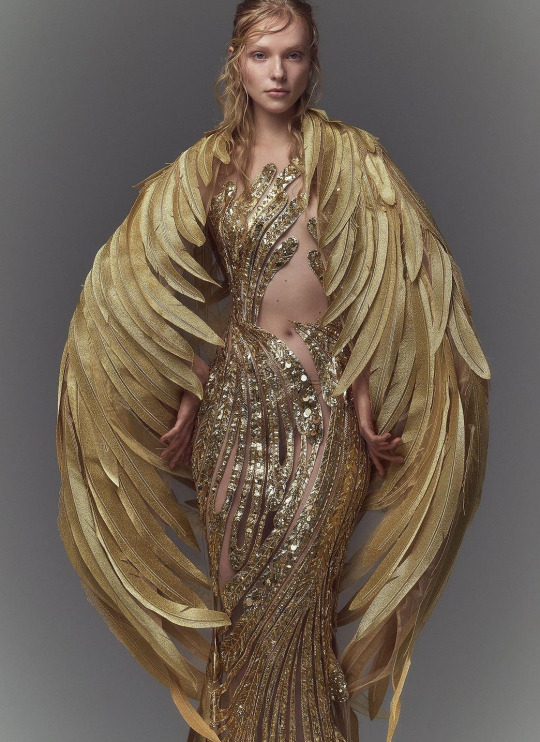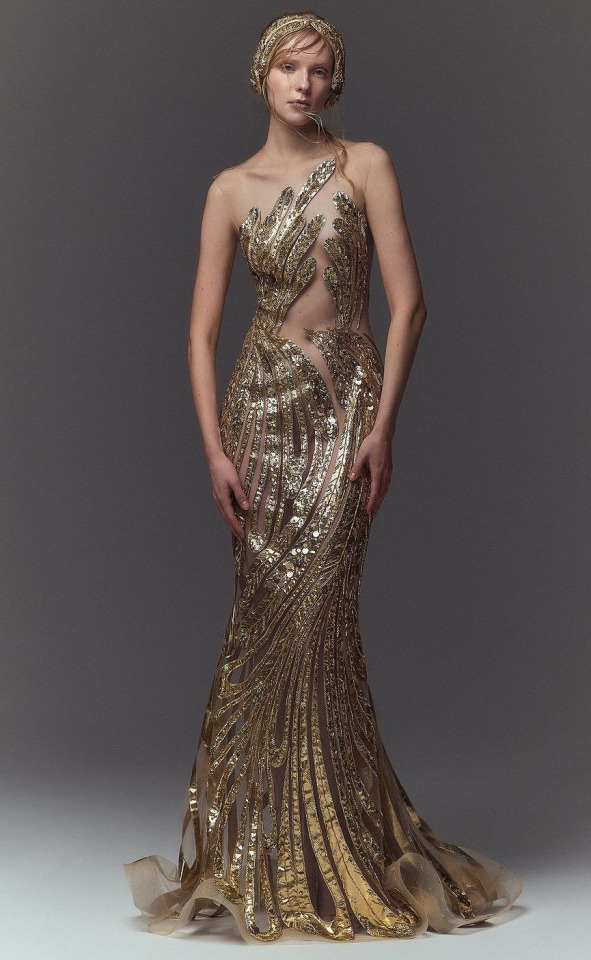Text
shén shòu神兽, mythological animals in chinese culture for references and inspiration part Ⅰ: nine offsprings of loong🐲🐉
In addition to the well-known Loong🐉 (dragon but not western dragon)and the Fenghuang(Phoenix), there are countless other divine beasts(or beasts of spiritualization) in Chinese mythology, their system is huge and complex, from various ancient texts and folklore, such as “Loong gives birth to nine offsprings 龙生九子”, meaning the nine descendants of Loong and they are born from the mating of Loong and other divine beasts, with different forms, and their images can often be seen in Chinese folk culture.
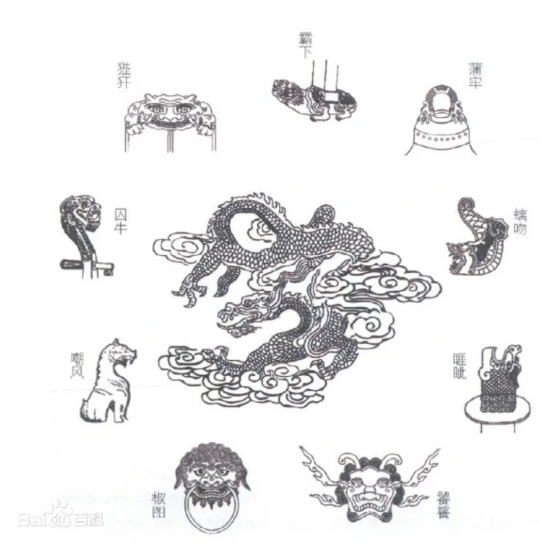
1. 囚牛[qiú niú]
Qiuniu, the eldest offspring of the dragon, is said to have loved music all his life. Legend has it that qiuniu was the most docile of all the dragon’s sons, and that it was not a killer or a fighter, but rather a musician. It had a head like a dragon and a body like a snake, and its hearing was so good that it could distinguish the sounds and the pitch of everything. It often crouches on ancient Chinese stringed instruments to enjoy the music of the plucked strings, which is why its statue was carved on them. ↓
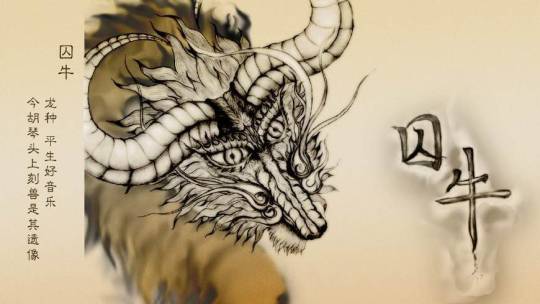
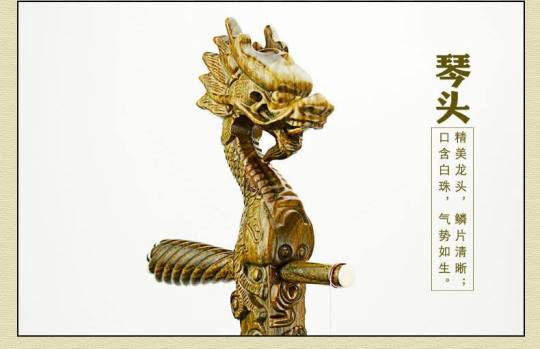
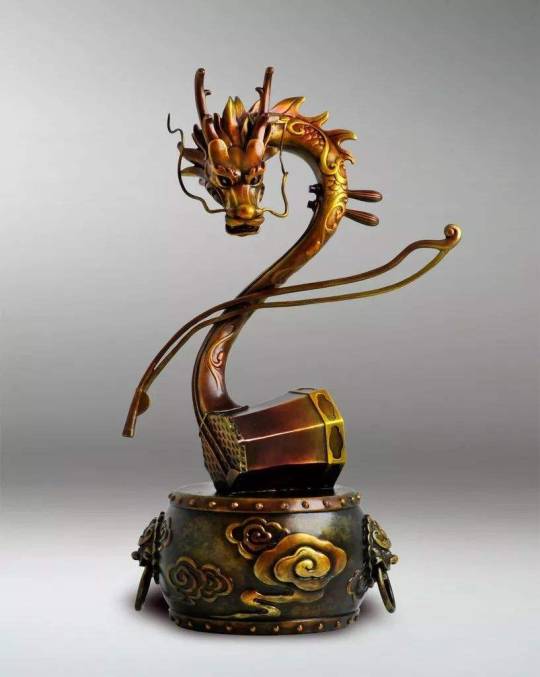
2. 睚眦[yá zì]
Yazi, the second offspring, has the head of a dragon and the body of a jackal, is fierce, courageous, bloodthirsty and murderous, and always has a sword in its mouth and a furious stare, often engraved on the handle of a sword as a symbol of guardianship and strength. The original meaning of yazi is to stare in anger, a symbol of blood and vengeance, and so yazi became the embodiment of the destruction of all evil. ↓
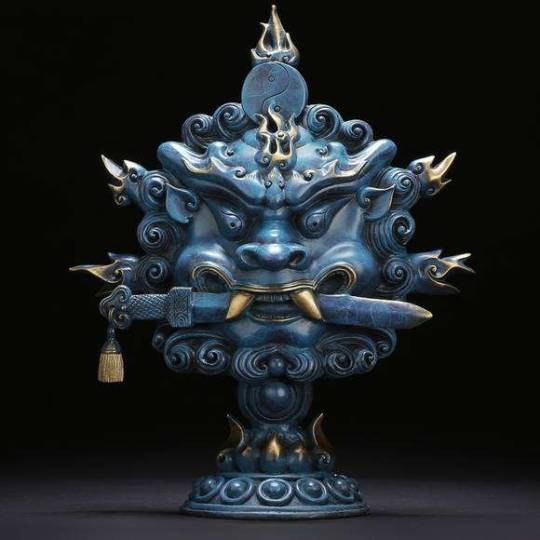
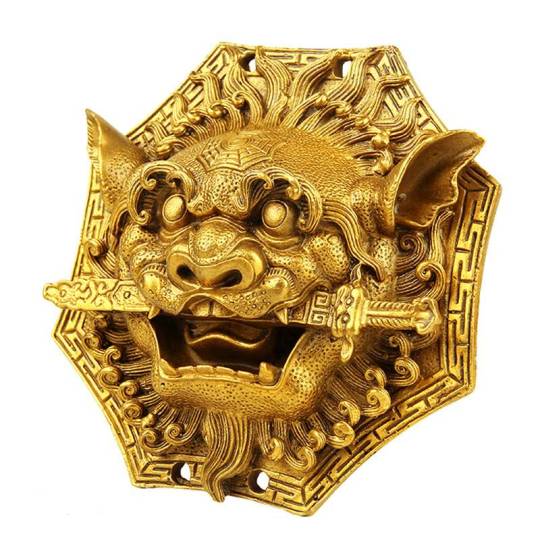
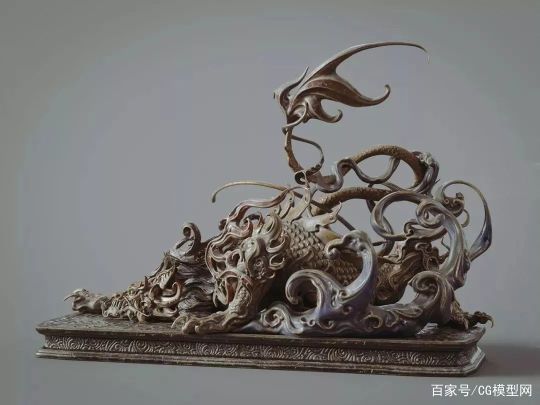
3. 嘲风[cháo fēng]
Chaofeng is the third in line and enjoys adventure and views from high places.
In Chinese folklore, chaofeng symbolises good fortune, beauty and majesty, and also serves to deter demons, remove calamities and ward off evil spirits. It adds a layer of mystery to a towering hall and can act as a deterrent to evil and avoid disaster. ↓
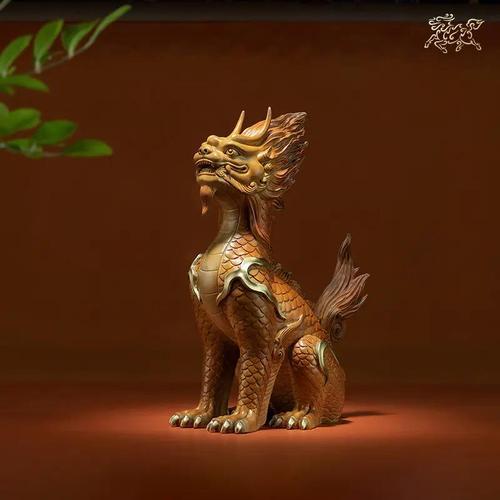


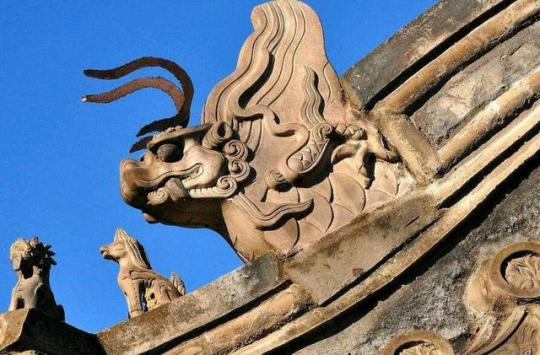
4. 蒲牢[pú láo]
Pulao loves sound and a good roar, and is often carved on the great bells of Chinese temples. Legend has it that the pulao lived by the sea and was terrified of whales. When the whale attacked, he was so frightened that he roared loudly. In response to its ‘fondness for roaring’, the pulao was cast on the bell of the temple and the wooden pestle used to strike the bell was carved in the shape of the whale. When the bell is struck, the whale strikes the pulao one after the other, so that the sound of the bell can be heard from very far. ↓
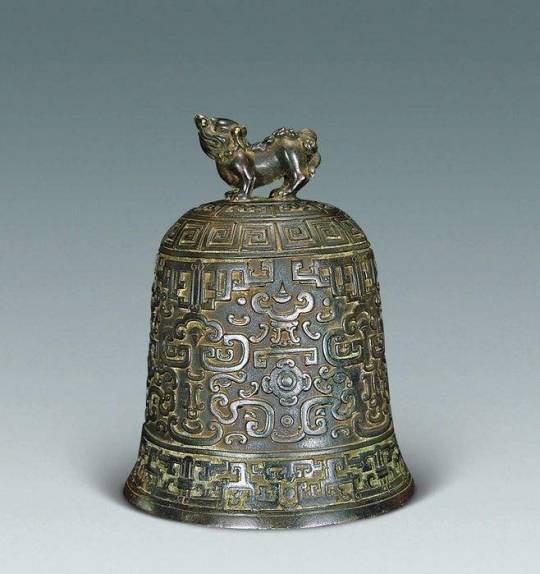
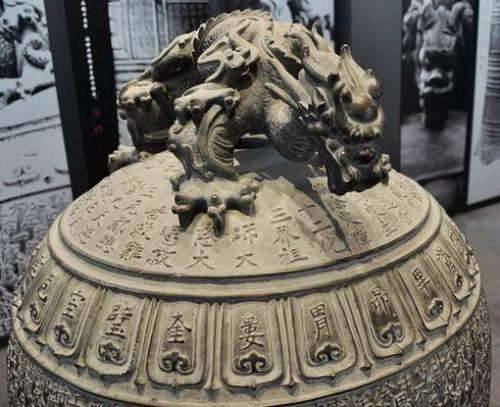
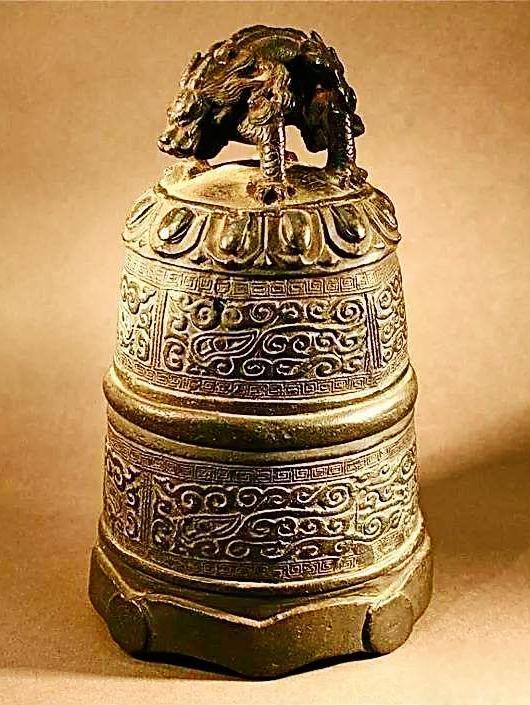
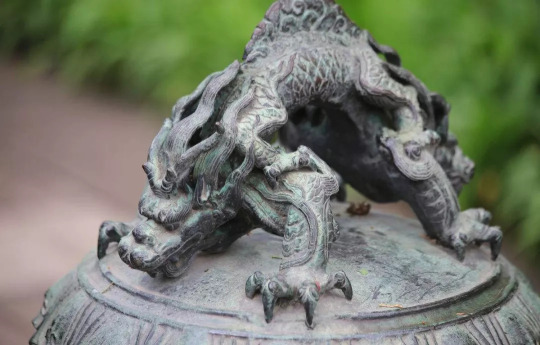
5. 狻猊 [suān ní]
Resembling a lion, suanni is a quiet and immobile creature that sits well and loves fireworks, and is often used to decorate the foot of incense burners.
There are three broad uses for the suanni. One is as a mount for a Buddha or Bodhisattva, a guardian animal. Legend has it that the suanni liked to sit quiet for long time, so when the Buddha saw that it had patience, he took it as a mount. Secondly, the suanni was regarded as a auspicious beast to ward off evil and was introduced into people’s practical lives, and was gradually used extensively in architectural decoration, folklore festivals and bronze mirror decoration. Thirdly, it was used to ward off evil spirits, to guard tombs, and to guard palace gates and mansions. In view of the supreme power of the Buddhist kung fu ‘lion’s roar’, suanni stone sculptures were used in the Sui and Tang dynasties to guard tombs to ward off evil spirits or to symbolise authority. ↓
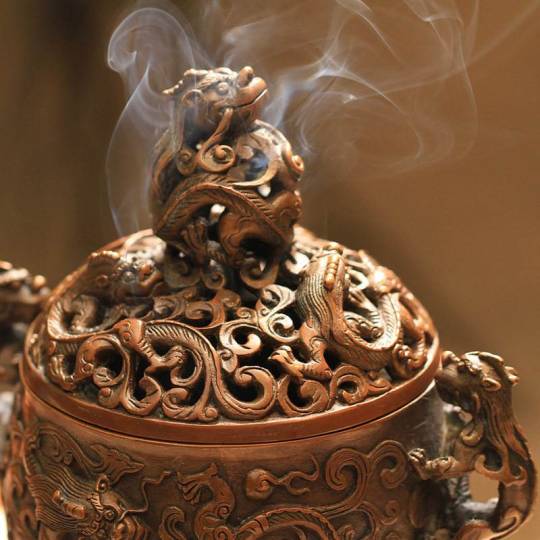
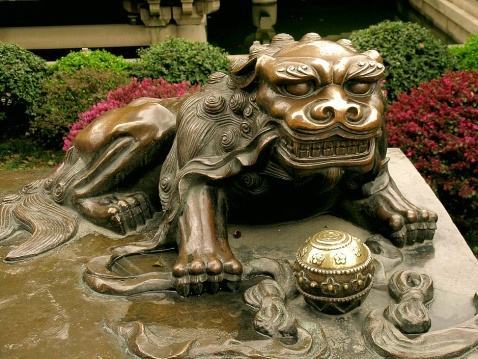
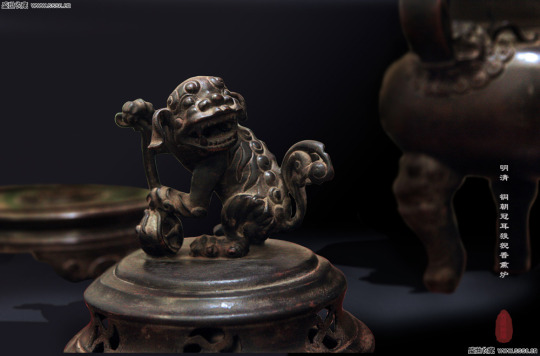
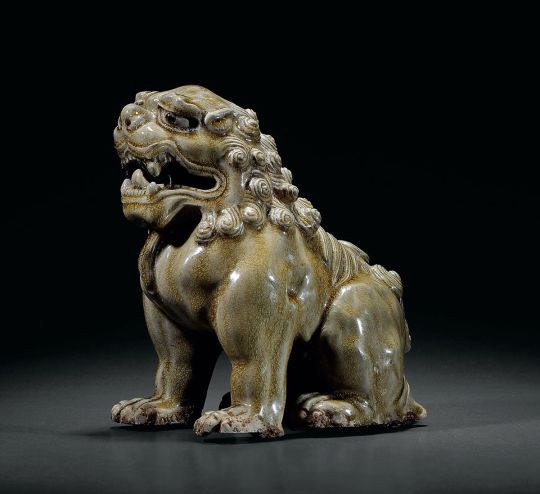
6. 赑屃[bì xì] Bixi is one of the nine sons of the dragon in ancient Han mythology, also known as baxia霸下 and ranked sixth. It has a tortoise-like appearance and likes to carry heavy loads on its back, often carrying stone monuments for years. Bixi is often used as a base for stone monuments, and is of great cultural importance. Its symbolism is based on 'longevity and good fortune’ and has connotations of status, totem worship and witchcraft. ↓
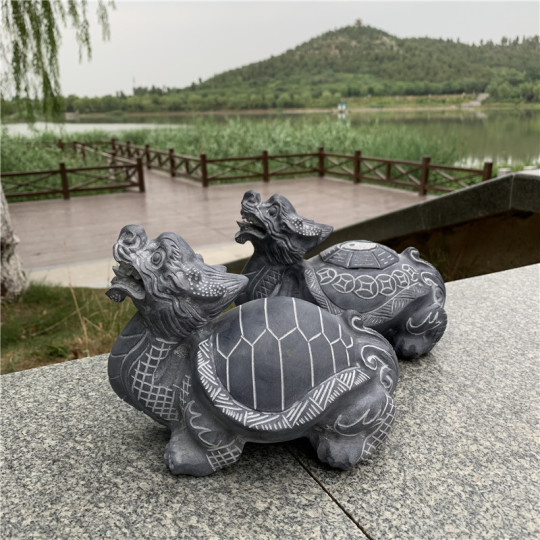
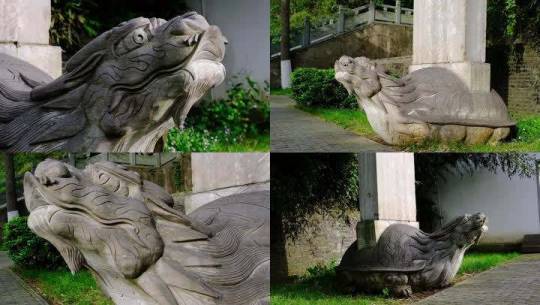
7. 狴犴bì àn, also known as Charter, is loong’s seventh offspring. It looks like a tiger, very powerful, and enjoy living a litigious life. The tiger head decoration on the prison door is Bian.
Ancient scripture《���经》notes: “Bian likes to argue, and it has a name called charter.” It is said that Bian is not only loyal to justice, but also able to distinguish right from wrong and judge justly. In addition to its majestic appearance, bian is not only decorated on the prison door, but also lying on both sides of the ancient government hall. Whenever the magistrate sits in the hall, Bian’s image is on the top of the title board and the silence board. Bian looks around fiercely to maintain the solemn integrity of the court.
Bian is both the symbol of prison and the patron saint of ordinary people. In 上虞区上浦镇冯浦村, shaoxing, zhejiang province, there are the cultural custom of 'Bian Loong dance狴犴龙舞’, which had local characteristics and are deeply welcomed by the local people. ↓


8. 负屃[fù xì ]
The fuxi is the eighth offspring born to the dragon in ancient Chinese mythology. Its body resembles that of a dragon and it has a gentle disposition, preferring to coil around the head of a stone monument. It is a lover of literature and calligraphy and likes to coil around the tops of stone monuments with beautiful inscriptions. It is usually seen together with the bixi, which carries the monument, and the fuxi coils around the top of the monument. ↓
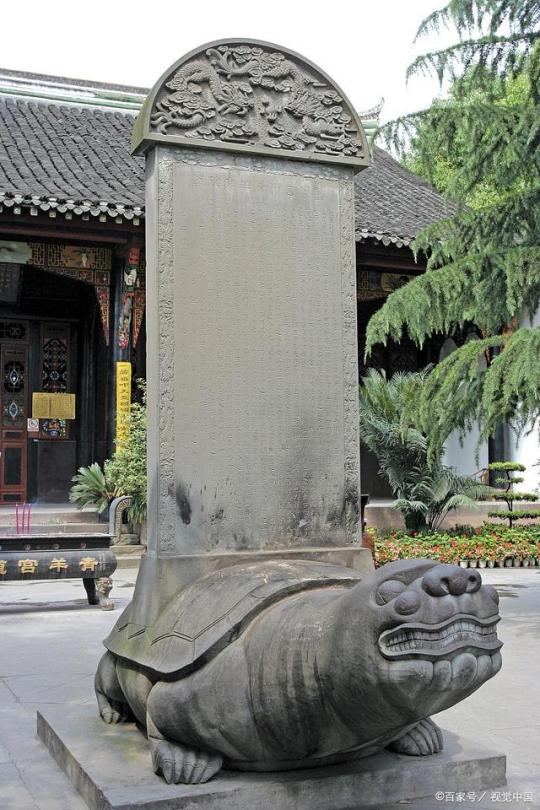
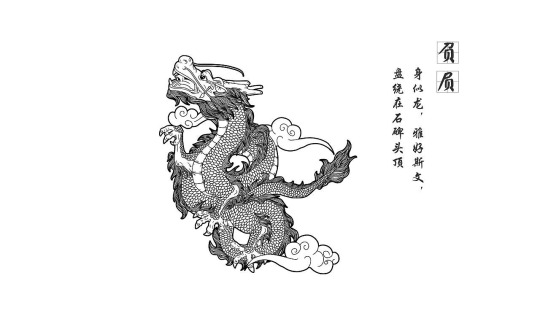
9. 螭吻 or 鸱吻 [chī wěn]
It is generally considered to be the ninth offspring of the dragon. It likes to swallow things and is said to be able to devour everything, as seen on the head of the beast on the roof of a Chinese palace. Chiwen likes to look around and is carved to look like it is swallowing the roof with its mouth open, and often has a sword stuck in its back. Legend has it that chiwen can spout waves and send down heavy rain, ward off fires and drive away spirits and demons. So Chinese folk asked it to watch over the horizontal ridges of houses. It likes to climb high and look down, so it is regarded as an ornament in folklore to pray for rain and to ward off fire. Chiwen is the child of a dragon and a fish, so its head is a dragon’s head but its body is in the shape of a fish. ↓

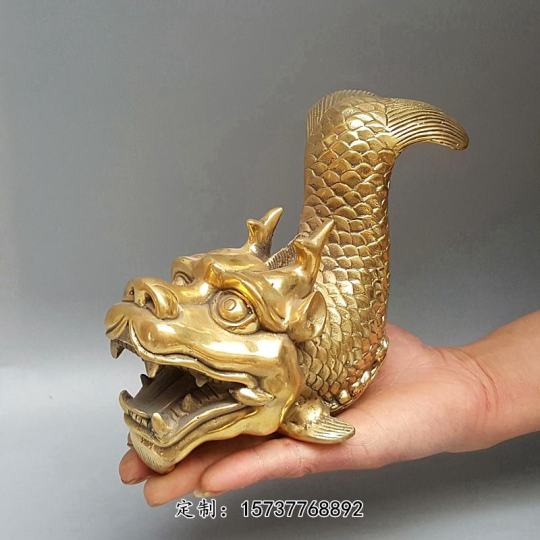
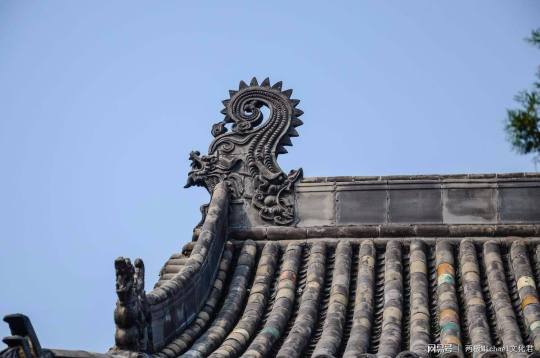
summary and some related patterns↓
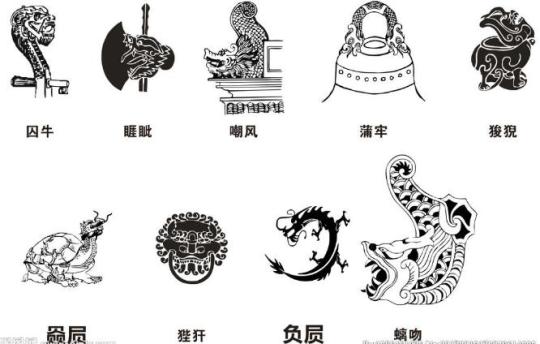
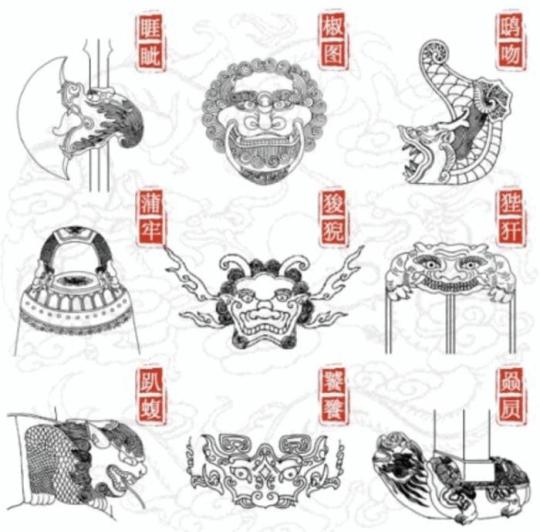
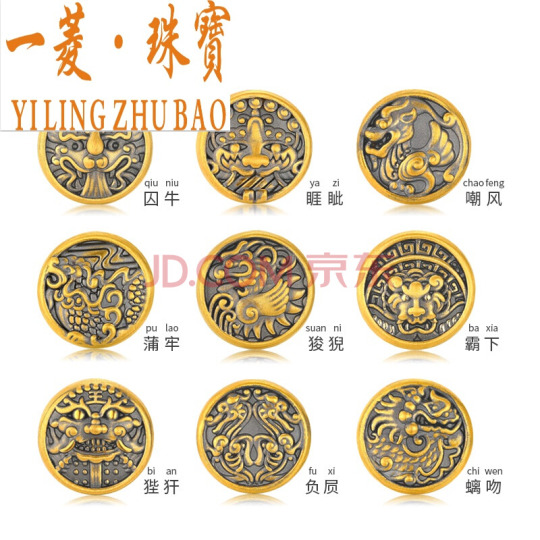
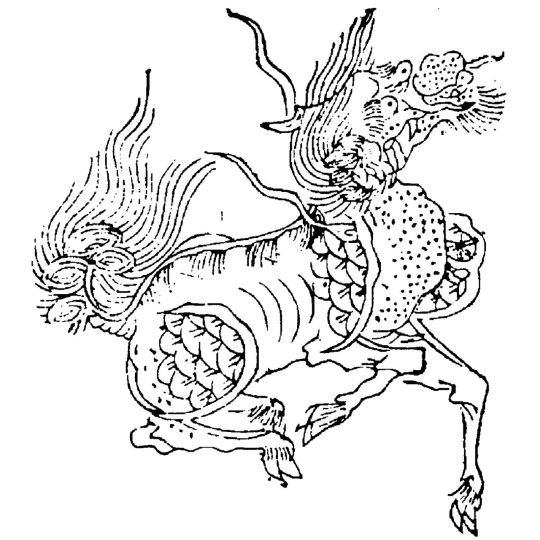
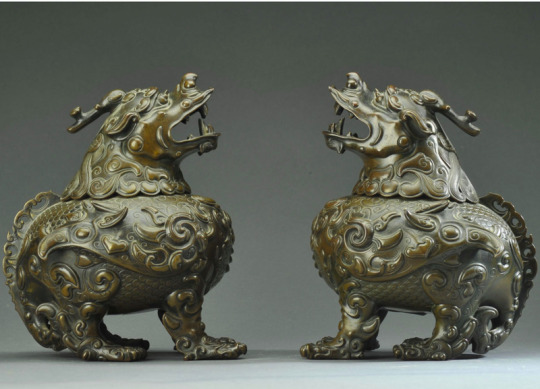
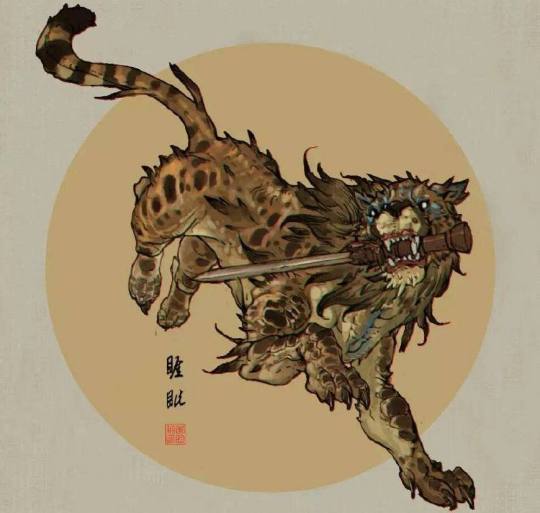
2K notes
·
View notes
Text
original character in chinese wuxia style of 旋风博文
68K notes
·
View notes
Text
Ghost Pokemon - Halloween 2023
Thank you for the support on this project! Now to the next one!
51K notes
·
View notes
Text
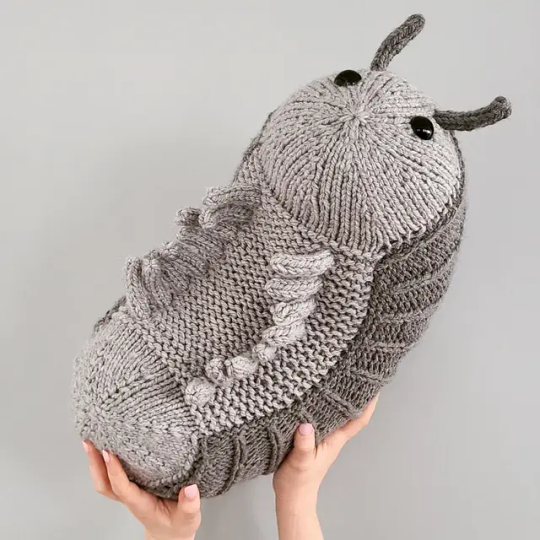
First time posting my knitting to tumblr. Look at my Bug Son
90K notes
·
View notes
Note
why does this have 305 citations? is this normal

insect
34K notes
·
View notes
Photo
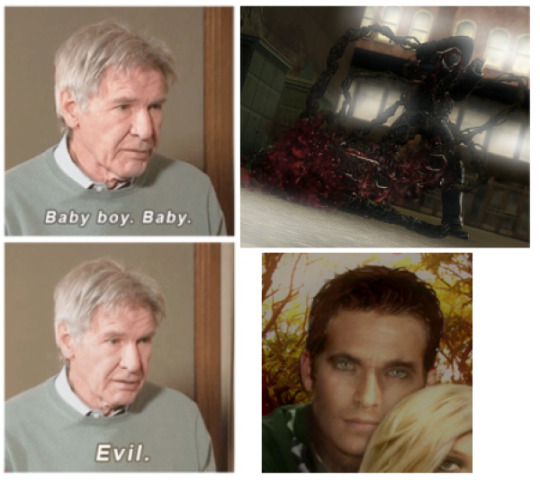
129 notes
·
View notes
Photo
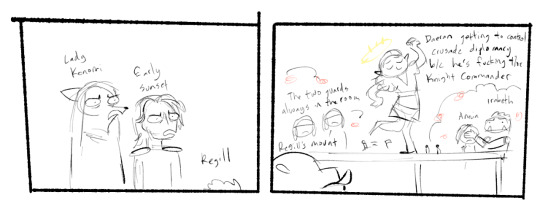

azata path is so goddamn funny
#regill derenge#wrath of the righteous#pathfinder wrath of the righteous#daeran arendae#early sunset#the unresolved and onesided s*xual tension between mephistopheles and regill derenge
78 notes
·
View notes
Text
Zak Was Supposed To Die For Real -- Theory
I have this conspiracy theory that, maybe in the first draft, Zak was actually supposed to die in the finale, and the funeral that the show ends on would be his funeral. This gets really deep into the show’s themes and symbolism, and picks apart the plot points in the rushed season 2. Thoughts as follows:
I’m gonna start with the fact that it’s really weird that our protagonist doesn’t have any speaking lines in the funeral scene - not even one. This show was so meticulously written up until that point that I really feel like they wouldn’t accidentally forget to write Zak lines - the original version of this scene, Zak couldn’t talk, because he was dead.
Now, that’s just kind of a weird little observation. More importantly, it makes a lot of narrative and thematic sense for him to have died for real, but the weird pacing of the last 3 episodes really serves to obfuscate it. Here’s the lead-up to Zak’s death in abstract - forget for a moment the weird pacing of the season, and imagine these plot beats with enough time to breathe:
Zak strikes a deal with Argost, which he KNOWS is a bad idea, to learn more about his powers, in exchange for Argost having access to him.
What Zak (12 year old boy) doesn’t realize is that what Argost really wants to do is isolate Zak from his family/support network and render him vulnerable and dependent on Argost. “Into the Mouth of Darkness” makes this really explicit - the “lesson” Argost “teaches” Zak is that Zak is a monster who’s betraying his family. On the other hand, Argost effects this “kindly uncle” act around Zak, including showing up for his birthday and giving him a “birthday gift” - the neural parasite. He is EXPLICITLY eroding Zak's trust and reliance on his own family, while building it towards himself - gaslight gatekeep girlbossing, if you will.
On the flip side, Zak is trying to beat Argost at his own game, by sending Doyle to do recon on Argost, trying to find some weakness to exploit or some dark history to use against him. This search winds up seemingly worthless - the investigation pretty much uncovers that Argost has always been a scheming, conniving, evil little bastard, and really only serves to piss Doyle and Drew the hell off when they realize that Argost killed their parents. Put a pin in this one, it’s really important.
There’s a constant tension in the narrative centered around Zak being Kur. Zak IS Kur. They are not separate entities. There is no way to destroy the Kur part without taking Zak with it because they are the same guy. There is a constant struggle here, which is said explicitly in “The Unblinking Eye,” “they can tell us what we are... but they can’t tell us what we have to be.”
The problem is... “what we are” looks increasingly inescapable - Zak’s powers are getting stronger and getting evil-er; he starts the season injuring his parents, and by the end of it, he nearly gets his friends all killed, and he absolutely has the power to cause an apocalypse if he wants to. It’s starting to seem more and more like the talking Lemurian altar in “Shadows of Lemuria” was right - “no creature can defy its nature.” Like it or not, Zak IS basically a walking apocalypse, and the more he interacts with the world, the more he’s confronted by this fact - everyone is scared of him, everyone either wants him dead or wants him collared, and he hurts people just by being around them because he’s dangerous. Even if these messages get refuted somewhat by the end of the episodes - the jadugar in “Legion of Garuda” doesn’t succeed in killing Zak, but wants Zak dead. Zak himself nearly gives up on being good because Tsul’Kalu, who is very much a Good Guy, wants Zak dead. Like, it’s bad for this little boy.
As the situation grows more and more unsalvageable, all characters involved become more and more driven by ego and pride. Argost and the nagas are there from the very beginning, their main motivation being egomania and species supremacy, respectively, but the Scientists take progressively more extreme stances (they go from “we chose this option BECAUSE IT WON’T HURT ZAK, we don’t want to hurt Zak,” to “Noted. I’ll let my feelings know they should be hurt”), AND the Saturdays becoming increasingly hostile to outside groups (we start the show at “we need to defeat Argost for the good of humanity” to “we need to beat the shit out of everyone who tries to hurt our son” to “we need to kill Argost for revenge because he killed our goddamn parents”).
Zak is desperately trying to be the voice of reason - the voice of what he was taught. It’s very consistent in this series that Zak’s family sometimes loses their way - Doyle wouldn’t have joined the family, due to his own trust issues and Doc and Drew’s wariness, if Zak hadn’t insisted that ohana means family and family means no one gets left behind or forgotten. In season 2, Zak’s the one who has to beg his parents to go out and help cryptids, when they’re willing to go full defense mode and hide Zak away. And that’s the same even leading up to the finale - with Doyle and Drew completely losing their shit trying to revenge-kill Argost, and Doc honestly kind of complicit because he has his own very personal beef, Zak is the one begging them not to.
So where we are at right now is that, thematically, the root cause of all the major problems in the show is ego. It’s pride, selfishness, and the callousness that results. Revenge, proving that you’re right, ambition and greed. The problem is that everyone is so up their own personal asses that they’ve lost sight of the actual good or harm they’re causing.
I want to mention that this is a very Hindu theme in a show with a shitton of Hindu symbolism. Kur itself is regularly identified with the Hindu god Shiva (you can read more about that here), and the Nagas speak Hindi/the Legion of Garuda is based on a Hindu legend, so it is by no means a stretch to bring a Hindu reading into the show.
To quote this website:
The Self is universal, eternal, one and without divisions. The expansive or exalted feeling that “I am everything” and “I am all,” this does not constitute egoism. However, the feeling that “I am so and so,” or “I have this and that,” constitute egoism or ahamkar. When the universal Self is covered with the impurities of delusion and ignorance, it develops this limited view of itself as a separate entity, which we recognize as ego.
Thus, the ego is the feeling of separateness, the sense of duality, or the idea of being distinct and different from others. It is the false perception of oneself as a separate being or a limited being. Egoism creates the limitations of space and time in which we become stuck.
Bringing this back to the show - as everyone’s motivations become more and more selfish and egoistic, and you could argue even Zak attempting to prove that he’s “this or that” counts, we have a culmination of this conflict in Weird World, where Drew actually succumbs to her desire for revenge and attempts to attack Argost and the Nagas, an act which ends with her disarmed and her own blade pointed at her.
(Drew’s blade, by the way, is specifically the khadga wielded by the bodhisattva Manjushri, which represents wisdom that cuts through duality and ignorance.)
What happens next is a major turning point in the narrative, and the rushed timing of season 2 didn’t do it justice. Van Rook sacrifices himself to save Drew, the only thing he liked “almost as much” as money. While this initially seems like shock value, people dying in a kid’s show, it’s much more than that. Van Rook’s death is the most major example of that which defies ego - selflessness.
We’ve seen smaller examples of this kind of selflessness throughout the series. Francis letting Zak go, or Wadi and Ulraj promising to stay by his side no matter what - but all of those have been salve on a wound. Their sentiments don’t fix anything or save anybody. But this, here? Van Rook sacrificing himself? That saved mom’s life.
The next thing that happens in the story is that Zak runs off to take Argost’s deal for a one on one confrontation. The pacing of the show makes it difficult to tell, but the way his dialogue is written, I’m firmly convinced that Zak went into that basement knowing that Argost was planning to kill him. He faintly jokes on the way down about them fighting “Kur versus Kur... or... anti-Kur... whatever.” But remember “Kur Rising” - “The jokes help me cope.” Let’s go back to our pin, the one on Doyle’s seemingly fruitless search for Argost’s weakness. This, here? This is the payoff for that.
You see, all that Doyle’s investigation turned up was that Argost has always been a selfish, egomaniacal, greedy, ambitious little bastard. And that’s his weakness. That’s what Zak takes away from Van Rook’s sacrifice. Let me transcribe his final words here:
I don’t need your mercy, Argost. I finally know how to end this -- all of it. Your whole life, all you’ve known is taking, and stealing, and grabbing for power. You’ll never understand what Van Rook did. Giving it all up to save the people you love. [...] Oh yeah, and you never were a very good scientist. You know why the world went crazy every time Zak Monday and I got too close? Matter and anti-matter don’t play well together. Have fun learning that lesson.
The final lines especially drive home to me that Zak knew what Argost was planning. Maybe not specifically how it turned out, but that Argost would try to steal his powers. Why? Because, according to Doyle’s investigation, that’s all that Argost has ever known. Greed, selfishness, and ego. Argost would not be able to resist a chance to steal Zak’s powers. He’d be blinded to the fact that this will destroy him. Zak went into that basement knowing he was going to die to the Flute of Gilgamesh.
Now, let’s go back to our website on Hinduism:
In our eagerness to be something, have something and find security, we build walls around ourselves and become prisoners of our own actions, losing sight of our innate ability to radiate the light of God and His unconditional love. We cease to see the divinity in ourselves as well as in ours. [...] The secret regarding unconditional love is that it manifests in you when your self-love becomes universal love. For that you have to see your inner Self everywhere and everything in your inner Self.
[...] A tree does not choose whom to give its fruit. It is we who build a fence around it. A well does not choose whom to give water. A river does not choose whose boat it will carry. A flower does not choose to whom it will spread its fragrance. The sun and moon do not choose to whom to radiate their warmth and light.
God's unconditional love manifests when we silence our desires and suspend our judgment. Both are difficult to practice. When they are absent, God's love manifests itself. It is in the silent heart of an ascetic yogi (muni) the spring of unconditional love wells up.
Zak is the one who begs his mother and uncle not to go down the path of vengeance, an entirely selfish pursuit. Zak is the one who forgives his uncle and reminds his family that they should love each other without judgment. And Zak is the one who has always reminded his parents that their job is to help the creatures of this earth. Argost, the embodiment of ego, would never be able to understand compassion, altruism, or sacrifice. That’s what Zak defeats him with.
There is also something to be said here that Zak’s powers - Kur’s powers - the part of the show most heavily associated with Hinduism - is to connect with cryptids. The universal, eternal, one-without-divisions Hindu concept of Self is precisely what Kur’s powers echo. Kur is this oneness, this universality.
To those of us with ego, to those of us with desires and attachments, it is a malignant and seemingly evil force. Kur, the destroyer. Kur, which destroys ego. Kur, a universal and eternal consciousness that grinds our pretensions of uniqueness or separateness to dust. And that is the state Zak attains with his sacrifice - he suffers an ego death, but his love remains. What his sacrifice means is an end to vengeance, an end to animosity, an end to the struggle for identity, in lieu of something beautiful. That makes this ending a resolution of the tension between “what we are” and “what we choose to be.”
He destroys Argost, the show’s greatest representation of ego, ego which causes all the problems, with the sacrifice of his own ego, fulfilling his duty as Kur. He cannot defy his nature, but he is also who he chooses to be - because he is everything, and everything is within him. That is the true nature of the Hindu concept of Self when the ego has been silenced.
And so we reach the funeral again, in this hypothetical where Zak stays dead. I want to focus here on the last words in the show:
Two is plenty.
This is already incredibly powerful when said by Doyle to Van Rook, a man who made a massive impact on his life, a man that he hated, but who lifted him out of poverty and inadvertently reunited him with his family. But imagine if he says this to Zak.
His relationship with Zak throughout the show is more than just uncle and nephew; it’s mentor and mentee. He occupies the same space in Zak’s life that Van Rook had in his own. Now, not only is he echoing Van Rook’s words from the very first episode - Van Rook who is also dead - but he is now the mentor, saying these words to his mentee, whom he will never finish training.
I think they’re more powerful then. It’s a final acknowledgement of the lessons that Zak and Van Rook taught them. Forgive, love each other, be one with everything and have everything within yourself. On top of that, with Zak specifically, it’s a way to mourn a relationship that will never see its proper conclusion.
And then I think the network took one look at this and went “you cannot, and I cannot stress this enough, cannot kill off the child protagonist of your children’s cartoon.”
#the secret saturdays#death ///////#zak saturday#leonidas van rook#v v argost#vincent vladislav argost#THE SHOW IS THAT DEEP#IT IS THAT DEEP#LOTS OF SHOWS ARE NOT THAT DEEP BUT THIS ONE IS
134 notes
·
View notes
Text
the way that kevin chu was SINGLEHANDEDLY fighting a battle to make alex mercer dress well and look handsome and was confounded at every turn
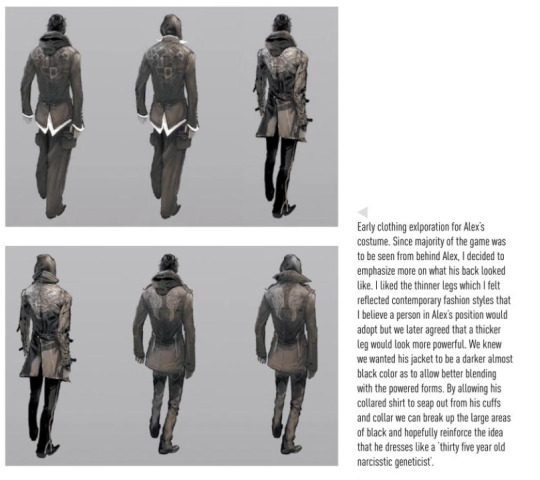
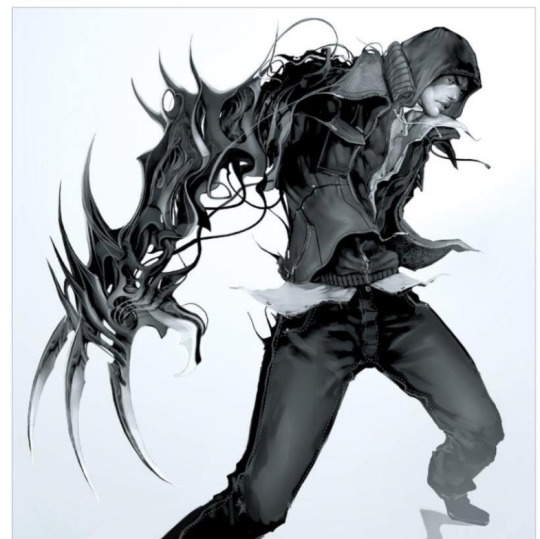

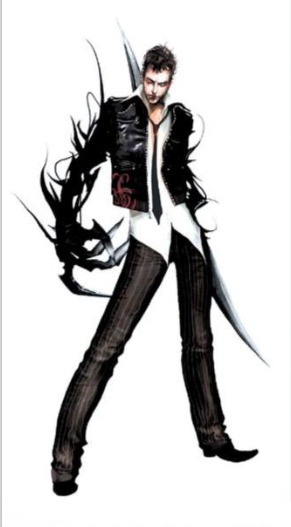
#rip well-dressed alex gone but not forgotten#prototype 2009#alex mercer#alexander j mercer#kevin's notes are consistently like#'he would dress well' 'this would be fashionable' 'he would wear this'#and you can see his really cool trench/three-fourths trench concepts get slowly whittled down into Generic Cool Toughguy#i could feel his soul dying with every pass#when he was finally forced to pop those collars . i cried#expensive fabrics and high-class styles and skinny pants and snatched waist showing off his fantastic ass#to a man who if we saw him on the street we would point and laugh. this is so tragic#kevin tried to make him a skinny little twink so hard#[prototype]
166 notes
·
View notes
Photo
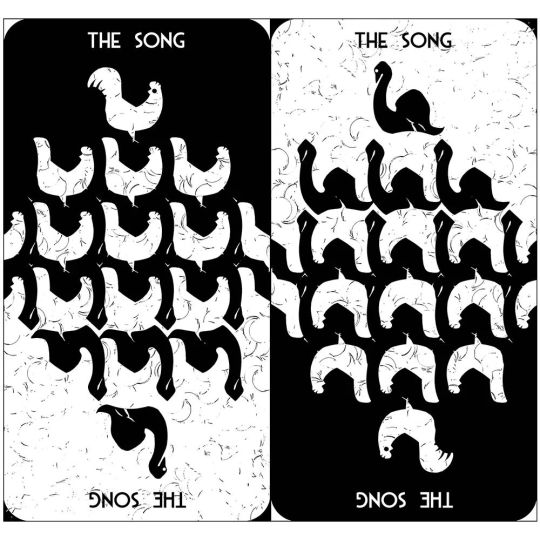


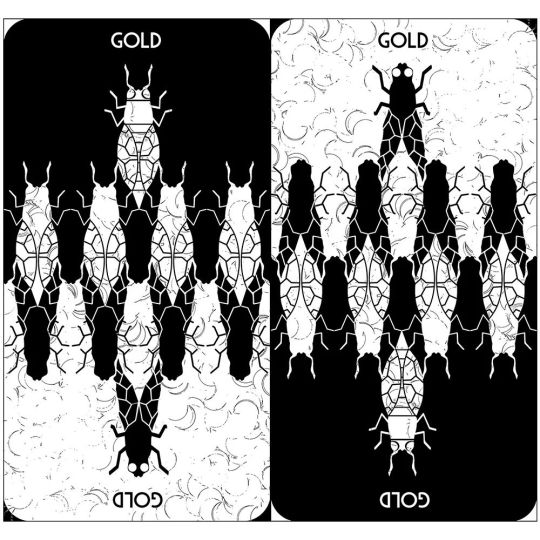
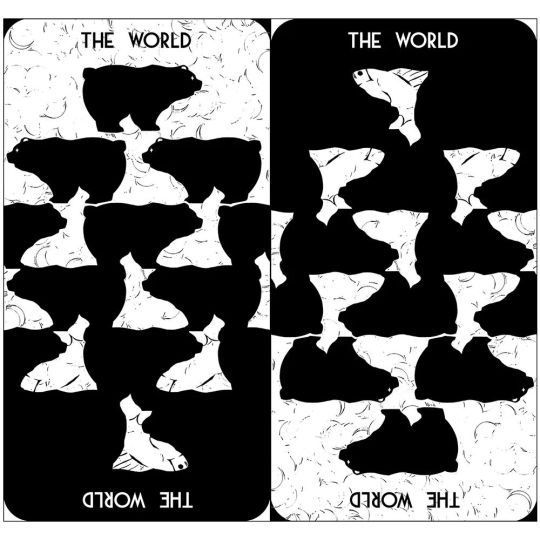
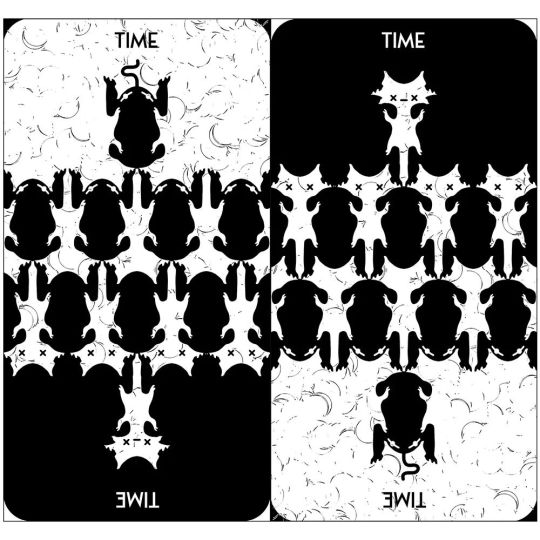
Home made Tarot by Romain MAZEVET
18K notes
·
View notes
Photo
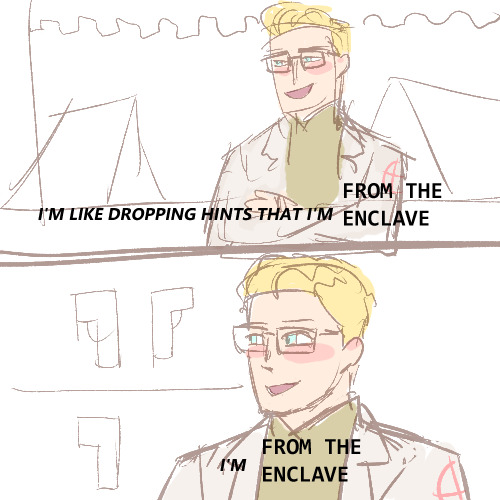
this has probably been done before
#my favorite white boy#arcade gannon#fallout new vegas#fallout nv#fallout: new vegas#most undeateable man in the world#simultaneously won't shut up about his evil past but also won't tell you about it#looks disappointed in you when you don't understand latin#''oh it's from the bible... you probably haven't heard of it''
454 notes
·
View notes
Note
The cryptid siblings being naturally drawn toward Zak is canon! :D Several of the episodes got “novelizations” where they were made into chapter books, and it’s part of Zak’s introductory spiel in each one that cryptids are both naturally drawn to him, and/or totally loyal. I believe these novelizations have been archived on archive.org, if you make an account, though sadly the Official Cryptid Field Guide has not been. It’s Vengeance of the Hibagon, King of Kumari Kandam, and Call of Kur (s2e1-2 without Doyle’s half of the story). I looked into these books because I thought they might be based on the scripts and not the final episodes, so they might have details that were cut from the final episode, and I was SO RIGHT. In Vengeance of the Hibagon, Zak cusses.
From Call of Kur:
“Zak had always had the mysterious ability to control cryptids. When he focused this power, he could make them do his bidding. And besides that, the creatures just seemed to be naturally drawn to him. His cryptid pets Zon, a flying pterosaur, and Komodo, a mutated Komodo dragon, were completely loyal. And Fiskerton, a furry, seven-foot-tall gorilla-cat, was like a brother to Zak.”
On the topic of foreshadowing, the globe-breaking thing is also my favorite because of how audacious it is. Here’s some more, with varying levels of confirmed intentionality:
Not only is Zak the last one to fall to the Devonian annelids, he’s ALSO the last one to fall to the owlman’s sleep induction, which causes the cultists to be so interested in him that they pick him out for the owlman’s meal.
Zak’s powers invert the blue tiger’s good luck abilities. When he actually uses his powers, it causes a massive surge of bad luck for everyone in the area; even when he doesn’t, his powers passively cause bad luck for just him.
Zak’s powers respond to the Tomb of Kur as a mystic hotspot.
Smoke mirror activated when Zak touched it, and leads to a world similar in description to the Sumerian netherworld (named Kur). This, however, might just be a coincidence, as the smoke mirror is already a very clear reference to the Aztec 5 suns myth.
Kur in the show is regularly associated with the Hindu god Shiva; one of his symbols (and indeed an important symbol in all of Hinduism) is his trident, or trishula. The Claw? 3-pronged.
At the time of the show’s creation, Kur was believed to refer to a massive serpent/dragon in the netherworld, which would make it the progenitor of the recurring water-associated serpent in all indo-european mythology, and the first mythological dragon. This has since been debunked, but, if you know about this fact... Zak’s shirt literally has a snake on it.


Sorry for the wall of text, I can just talk about this literally forever. Hope that was interesting, if long-winded!
Random question, but do you have any thoughts about tss and season 1 foreshadowing about Zak being Kur? Like, someday I'm gonna go through and rewatch everything properly so I can see if there's any more, but off the top of my head I remember Zak lasting the longest against the life-essence-eating bugs in the pilot and Fiskerton breaking an entire globe to point directly at Zak when he was like 'hey show me where we find Kur', and I was wondering if you knew any other examples/had any other thoughts on it
fisk breaking the globe to point directly at zak is always my favorite example of that foreshadowing... other than that i have a bit of a headcanon that fisk, komodo, and zon all joined the family in part because of a subconscious feeling of being drawn towards zak
like, in the flashbacks in "the kur guardian," fisk doesn't really trust doc and drew (and komodo) nearly as much as he inherently trusts zak. that's not really a kur thing but i like to think of it as one
35 notes
·
View notes
Photo

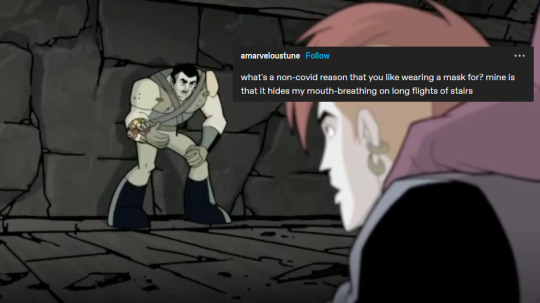


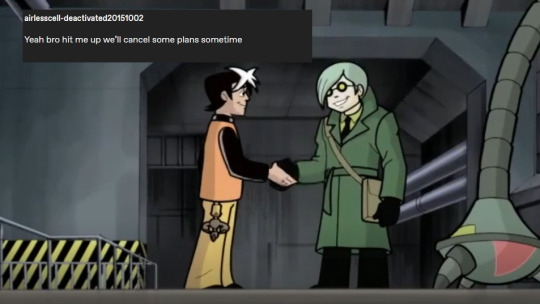


and bonus spoiler one

#the secret saturdays#zak saturday#arthur beeman#rani nagi#leonidas van rook#THERE AREN'T ENOUGH IN THE FANDOM I HAD TO MAKE MY OWN
158 notes
·
View notes
Photo
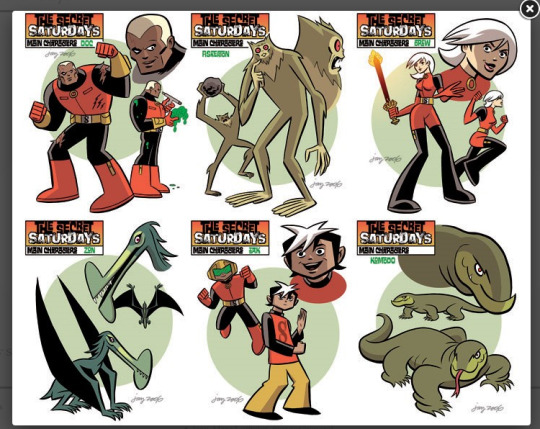
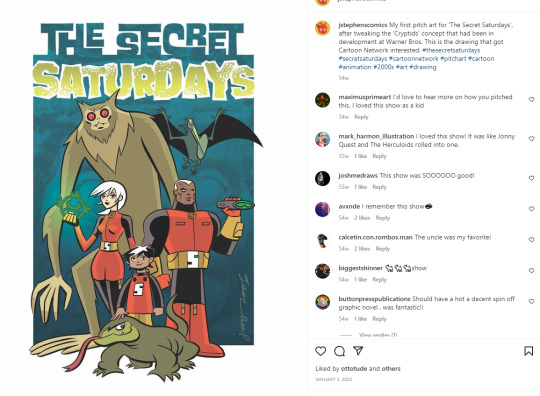

-thinks about them- -thinks about them- -thinks about them-
also, the weapon drew has in picture 2 is a wind-and-fire wheel

#the secret saturdays#zak saturday#doc saturday#drew saturday#LOSING IT CONSTANTLY that zak used to be named francis#-thinks about it-
185 notes
·
View notes
